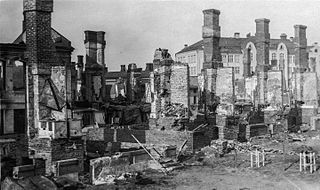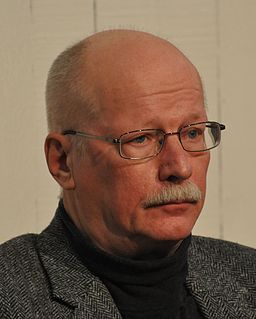
The Finnish Civil War was a civil war in Finland in 1918 fought for the leadership and control of the country between White Finland and the Finnish Socialist Workers' Republic during the country's transition from a grand duchy of the Russian Empire to an independent state. The clashes took place in the context of the national, political, and social turmoil caused by World War I in Europe. The war was fought between the "Reds", led by a section of the Social Democratic Party, and the "Whites", conducted by the conservative-based senate and the German Imperial Army. The paramilitary Red Guards, which were composed of industrial and agrarian workers, controlled the cities and industrial centers of southern Finland. The paramilitary White Guards, which consisted of land owners and those in the middle- and upper-classes, controlled rural central and northern Finland, and were led by General C. G. E. Mannerheim.

Posti Group Oyj, trading internationally as Posti Group Corporation, is the main Finnish postal service delivering mail and parcels in Finland. The State of Finland is the sole shareholder of the company. Posti has a universal service obligation that entails weekday deliveries of letters in all of Finland's municipalities. Posti's head office is located in Pohjois-Pasila in Helsinki. Posti's history spans nearly 400 years.

The Finnish Socialist Workers' Republic (FSWR), more commonly referred to as Red Finland, was a self-proclaimed Finnish socialist state that ruled parts of the country during the Finnish Civil War of 1918. It was outlined on 29 January 1918 by the Finnish People's Delegation, the Reds and Red Guards of the Finnish Social Democratic Party, after the socialist revolution in Finland on 26 January 1918. Its sole prime minister was Kullervo Manner, chairman of the central committee.

Kari Peter Conrad von Bagh was a Finnish film historian and director. Von Bagh worked as the head of the Finnish Film Archive. He was the editor-in-chief of Filmihullu magazine and co-founder and director of the Midnight Sun Film Festival. Since 2001, he had been the artistic director of the film festival Il Cinema Ritrovato in Bologna. Von Bagh was a member of the jury in the competition category of 2004 Cannes Film Festival.

Finland competed at the Summer Olympic Games for the first time at the 1908 Summer Olympics in London, United Kingdom. The Grand Duchy of Finland was part of the Russian Empire at the time, but Finland had become a sovereign member of the International Olympic Committee in 1907.

Mauno Jokipii was a Finnish professor at the University of Jyväskylä in history specializing in World War II. He was a thorough investigator and a prolific author. Among his works were studies of the local history of Jyväskylä and the university and historical province of Satakunta.

Sulo Arvi Pohjanpää was a Finnish Olympic gymnast, judge and writer.

Voitto Valdemar Kolho was a Finnish sport shooter, who won an Olympic bronze and five Finnish national championships.

This is a survey of the postage stamps and postal history of Estonia. The stamps of Estonia are issued by the postal administration Eesti Post which is the country's only provider of universal postal services.

Timo Juhani Vihavainen is a Finnish historian and a professor of Russian Studies at the University of Helsinki. He has written extensively on Russian and Finnish history. Vihavainen graduated as a Master of Philosophy in 1970, a Licentiate in Philosophy in 1983, a Doctor of Philosophy degree in 1988 and a Docent in Russian history in 1992. He is a member of the Finnish Academy of Science and Letters since 2009.

This is a survey of the postage stamps and postal history of Åland.

Seppo Erkki Sakari Heikinheimo was a Finnish musicologist, music journalist, writer and translator.

The Tom of Finland stamps are a 2014 issue of three Finnish first-class stamps drawn by and celebrating the work of Finnish artist Tom of Finland.

The Republic of North Ingria was a short-lived state of Ingrian Finns in 1919–1920, which seceded from Soviet Russia after the October Revolution. Its postal system was operated by the local government in co-operation with the Ministry of Transport and Public Works of Finland and the Finnish postal service.
Finnish national symbols are natural symbols or Finnish national works and prominent figures that are commonly associated with Finland. The most recognized national symbols include the flag of Finland and the lion featured on the Finnish coat of arms.

Pekka Heikki Tapani Gronow is a Finnish ethnomusicologist and historian of the recording industry. He studied at Wesleyan University with David P. McAllester and Robert E. Brown and at the University of Helsinki and received his PhD from the University of Tampere. He was the head of the record library at Yleisradio 1989–2006 and an archiving specialist 2007–2008. Gronow became known in the 1960s for his radio programs on jazz and blues. In 1966 he founded with M. A. Numminen Eteenpäin, a record company which issued Numminen's works and other underground artists.

Jukka Mallinen is a Finnish author, poet, translator and interpreter.

In Finland, the far right was strongest in 1920–1940 when the Academic Karelia Society, Lapua Movement, Patriotic People's Movement (IKL) and Export Peace operated in the country and had hundreds of thousands of members. In addition to these dominant far-right and fascist organizations, smaller Nazi parties operated as well.

The Peasant March was a demonstration in Helsinki on 7 July 1930 by the far-right Lapua movement, attended by more than 12,000 supporters from all over the country. It was the most significant show of strength in the short history of the Lapua movement, aimed primarily at the Communists, but it was also intended to put pressure on the Finnish government. President Lauri Relander, Prime Minister Pehr Evind Svinhufvud, among others, were invited guests at the main event held at the Senate Square. In addition present were right-wing MPs, the country's military leadership, and General Mannerheim, commander-in-chief of the Civil War White Army. The peasant march was intentionally reminiscent of the White Victory Parade of 16 May 1918, and also followed its route.


















